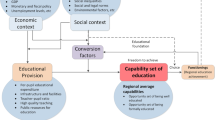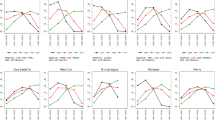Abstract
This paper analyzes the roles of location (rural and urban sectors) and education in the distribution of economic well-being in Indonesia by employing the hierarchical and non-hierarchical decomposition methods of the Theil indices. This is done by using household expenditure data from the national socio-economic survey (Susenas) in 2008. It shows that there are large expenditure disparities across education levels but that these are more pronounced in the urban sector than the rural sector. When there are differences in educational structure between the rural and urban sectors, the hierarchical decomposition method appears to offer a better approach than the non-hierarchical method.
Similar content being viewed by others
Notes
The primary education group includes households whose heads have either no education, incomplete primary education or primary education. The secondary group consists of households whose heads completed junior high school or senior high school, whereas the tertiary group includes households whose heads completed two-year junior college, three-year junior college, four-year university/college, or graduate school (master’s or doctoral program).
Except the Blinder-Oaxaca decomposition, all the results are weighted results based on sample weights.
The paper presented only the decomposition results of the Theil \(T\), since the implications of the Theil \(L\) results are similar to those of the Theil \(T\) results. The Theil \(L \)results are available from the authors upon request.
Regression results for the urban, rural and pooled models are given in Table 7 in the Appendix.
References
Akita, T.: Decomposing regional income inequality in China and Indonesia using two-stage nested Theil decomposition method. Ann. Reg. Sci. 37(1), 55–77 (2003)
Akita, T., Miyata, S.: Urbanization, educational expansion, and expenditure inequality in Indonesia in 1996, 1999, and 2002. J. Asia Pac. Econ. 13(2), 147–167 (2008)
Balisacan, A. M., Fuwa, N.: Changes in spatial income inequality in the Philippines. UNU/WIDER Research Paper No. 2004/X, Helsinki (2004)
Blinder, A.S.: Wage discrimination: reduced form and structural estimates. J. Hum. Resour. 8(4), 436–455 (1973)
Bourguignon, F.: Decomposable income inequality measures. Econometrica 47(4), 901–920 (1979)
Elbers, C., Lanjouw, P., Mistiaen, J.A., Ozler, B.: Reinterpreting between-group inequality. J. Econ. Inequal. 6(3), 231–245 (2008)
Estudillo, J.P.: Income inequality in the Philippines, 1961–91. Dev. Econ. 35(1), 68–95 (1997)
Glewwe, P.: The distribution of income in Sri Lanka in 1969–70 and 1980–81: a decomposition analysis. J. Dev. Econ. 24(2), 255–274 (1986)
Ikemoto, Y.: Income distribution in Thailand: its changes, causes, and structure. University of Tokyo Press, Tokyo (1991)
Neumark, D.: Employers’ discriminatory behavior and the estimation of wage discrimination. J. Hum. Resour. 23(3), 279–295 (1988)
Oaxaca, R.: Male-female wage differentials in urban labor markets. Int. Econ. Rev. 14(3), 693–709 (1973)
Rao, V.V.B., Banerjee, D.S., Mukhopadhaya, P.: Earnings inequality in Singapore. J. Asia Pac. Econ. 8(2), 210–228 (2003)
Shorrocks, A.: The class of additively decomposable inequality measures. Econometrica 48(3), 613–625 (1980)
Shorrocks, A., Wan, G.: Spatial decomposition of inequality. J. Econ. Geogr. 5(1), 59–81 (2005)
Tang, K.K., Petrie, D.: Non-hierarchical bivariate decomposition of Theil indexes. Econ. Bull. 29(2), 918–927 (2009)
Tsakloglou, P.: Aspects of inequality in Greece: measurement, decomposition and intertemporal change, 1974, 1982. J. Dev. Econ. 40(1), 53–74 (1993)
Author information
Authors and Affiliations
Corresponding author
Additional information
Takahiro Akita is grateful to the Japan Society for the Promotion of Science for its financial support (Grant-in-Aid for Scientific Research No. 24530274). The authors thank anonymous referees for their helpful comments and suggestions.
Rights and permissions
About this article
Cite this article
Akita, T., Miyata, S. The roles of location and education in the distribution of economic well-being in Indonesia: hierarchical and non-hierarchical inequality decomposition analyses. Lett Spat Resour Sci 6, 137–150 (2013). https://doi.org/10.1007/s12076-013-0093-8
Received:
Accepted:
Published:
Issue Date:
DOI: https://doi.org/10.1007/s12076-013-0093-8
Keywords
- Inequality
- Hierarchical and non-hierarchical decompositions
- Theil indices
- Urban and rural locations
- Education
- Indonesia




